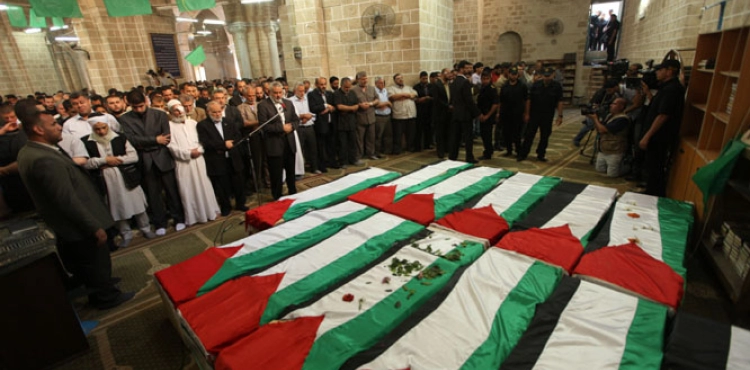Coincides with today; February 25, the 27th anniversary of the massacre of the Ibrahimi Mosque in the city of Hebron (southern occupied West Bank), committed by settler Baruch Goldstein, against worshipers while they were performing the dawn prayers, by shooting at them.
This massacre resulted in the death of 29 Palestinians and wounding about 200 others, before the killing of Goldstein, who carried out his crime with the help of other settlers and with the complicity of the occupation army. The chapters of the crime began at dawn on the 25th of Ramadan in 1994 (corresponding to February 25), and were followed by the imposition of the occupation of facts on the ground through the division of the Ibrahimi Mosque and the measures imposed later and changed the features of the entire region. After the massacre, the occupation closed the Ibrahimi Mosque and the Old City of Hebron for a full 6 months, under the pretext of an investigation into the massacre. The chapters of the crime were not limited to what the settler Goldstein committed, but the occupation soldiers shot the mourners, which raised the number of victims to 50 martyrs and 350 wounded, and tension and confrontations pervaded the West Bank and Gaza Strip and the occupied interior 48. The massacre was nothing but a cycle of continuous terror in its various forms, including killing, Judaizing and continuous attacks against human beings and Islamic sanctities, in a desperate attempt to neglect and obliterate the Arab and Islamic identity of the Ibrahimi Mosque. Judaization is being confronted by the Palestinians with all possible tools. The evidence for that is the Great Dawn campaign that was launched on January 31 to protect the Islamic holy sites from the threat of Judaization, to reflect a new phase of the conflict with the Israeli occupation. Shamgar, and UN decisions And unilaterally, a committee known as "Shamgar" was formed to investigate the massacre and its causes. At the time, it came out with several recommendations, including dividing the Ibrahimi Mosque into a synagogue and a mosque, so that the entire Haram would be opened for 10 days for Muslims in a year only, and the same period for the Jews. The UN Security Council ratified; On March 18, 1994, the resolution condemned the Brahimi massacre and called for measures to be taken to protect the Palestinians, including the disarmament of settlers. The United Nations Educational, Scientific and Cultural Organization declared "UNESCO"; Beginning of July 2017, the Old City of Hebron was declared as a "protected area" as a site of "exceptional international value." And this followed the vote of 12 members of the "World Heritage Committee" of the United Nations in favor of the resolution, compared to opposition only three and six abstentions from participating in the voting process. Attacks and checkpoints Since the massacre occurred, the attacks on Brahimi continued, and the old municipality in its vicinity was closed, and Al-Shuhada Street (central Hebron), which is the main artery and lifeline for Palestinians, was closed, which led to the closure of 1,800 shops in the Old City. It was also prohibited to raise the call to prayer in the mosque hundreds of times, and the city of Hebron and its old town were separated from its surroundings through nearly 120 military checkpoints. Those coming to pray in the mosque from the Old City must pass a military checkpoint of 3 stages in less than 10 meters: a vertical rotating gate, an electronic gate, and an iron gate adjacent to a populated military post. In the second stage, and about another ten meters away, a group of adjacent electronic gates, and here the worshipers must push a horizontal iron gate, then the metal detector electronic gate, followed by the phase of checking identities by soldiers behind the glass, then demobilizing through a horizontal metal gate to the entrance to the mosque. Before these checkpoints, there were two points on the way to the mosque for the occupation army, with about 12 soldiers deployed, the first at the beginning of the ascending stairs to the mosque and adjacent to its western wall, and the second at the direct door of the mosque at the top of the stairs. It is noteworthy that the occupation authorities deliberately prevented the call to prayer in the Ibrahimi Mosque under the pretext of disturbing the settlers, and the Muslim worshipers were subjected to extortion and searches at electronic gates and military checkpoints leading to the Ibrahimi Mosque and the old city of Hebron. Crime bullets "witness to it" The sides of the Ibrahimi Mosque in Hebron still contain the effects of the bullets of the massacre, in addition to the memories of the families of the martyrs and the wounded that remain on the wound without healing. The Waqf documented the bullets of the massacre of the occupation, which affected the Ishaq area and the mihrab, in a deliberate manner to target the imam and entrap the largest number of worshipers, and despite the restoration operations, they still testify to the crime. The endowment displays the effects of the crime to the visitors, which are still witnesses to the reality imposed by the occupation after the massacre. The Ibrahimi Mosque is located in the Old City of Hebron, in the area controlled by the Israeli occupation army, and inhabited by about 400 settlers guarded by about 1500 Israeli soldiers. Settlers claim their right to many Islamic historical sites in the West Bank, while studies, scientific research and historical studies deny these allegations. It is noteworthy that the World Heritage Committee of the United Nations Educational, Cultural and Scientific Organization "UNESCO" included in 2017 the Ibrahimi Mosque and the Old City of Hebron on the World Heritage List.












